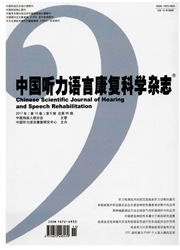

 中文摘要:
中文摘要:
目的通过分析船队工作人员的听力情况,了解相关人员听力损失及耳鸣现状,为进一步完善噪声防护提供依据。方法对噪声岗位97名、非噪声岗位28名工作人员行声导抗和纯音测听(0.25~8kHz)检查,通过问卷调查工作人员的耳鸣情况。结果非噪声、噪声岗位人员的平均听阈分别为25.39±9.67dBHL、31.85±10.20 dB HL,语言频率听阈分别为24.51±8.84dBHL、30.63±10.28 dB HL,高频听阈分别为27.99±17.75dBHL、34.73±16.97dBHL,低频听阈为25.04±8.20dBHL、33.97±10.16dBHL。非噪声、噪声岗位人员的耳鸣发生率分别为10.71%和53.61%。结论船舶噪声不仅引起高频听力损失,低频听力也出现下降。噪声岗位人员的耳鸣发生率是非噪声岗位人员的4~5倍。
 英文摘要:
英文摘要:
Objoctivo To analyze the hearing test results of the ship's staff, to investigate the hearing status of relevant staff regarding hearing loss and tinnitus and to provide references for the further improvement of noise protection. Methods 97 noise-exposed staff members and 28 non-noise-exposed staff members received acoustic immittance measurement, puretone audiometry (0.25-8 kHz) and a questionnaire survey on tinnitus. Results The average hearing thresholds of non-noiseexposed staff members and noise-exposed staff members were 25.39~9.67 dB HL and 31.85~10.20 dB HL, respectively. The hearing thresholds of non-noise-exposed and noise-exposed staff members at the speech frequency range were 24.51±8.84 dB HL and 30.63~10.28 dB HL, respectively. The high-frequency hearing thresholds of non-noise-exposed and noise-exposed staff members were 27.99~17.75 dB HL and 34.73±16.97 dB HL, respectively. The low-frequency hearing thresholds of non-noise-exposed and noise-exposed staff members were 25.04~8.20 dB HL and 33.97±10.16 dB HL, respectively. The incidences of tinnitus were 10.71% and 53.61% for the non-noise-exposed staff members and noise-exposed staff members, respectively. Conclusion Ship noise not only causes hearing loss at high frequencies, but also results in hearing impairment at low frequencies. The incidence of tinnitus in noise-exposed staff members is 4-5 times as high as that in non-noiseexposed staff members.
 同期刊论文项目
同期刊论文项目
 同项目期刊论文
同项目期刊论文
 期刊信息
期刊信息
